|
Recent Entries to this Blog
Happy Creatures
Posted: 02 Apr 2024 Posted: 29 Sep 2023 Posted: 05 May 2023 Posted: 01 Mar 2023 Posted: 19 Jan 2023 All Entries |
marlingardener's BlogFarm living and laughing
You can judge a man by his boots
Category: Farm Doings | Posted: Mon Aug 25, 2014 3:34 pm You can judge a man by his boots. Almost everyone around here wears boots and the boots tell a lot about the wearer. If the boots are pointy-toed and rake heeled, either the wearer does a lot of line dancing or is just dressed for the part. Do not hire this person for any serious work. If the boots are pointy-toed and have a heel, look at the side of the boot just above the instep. If the color is rubbed off, the wearer does a lot of riding. A stirrup will rub the boot at that point and remove any dye from the leather. Hire this person to move cattle from pasture to pasture, or to rope that nasty bull you're afraid to approach. If the boot has a rounded toe and flat heel, it's a work boot. The wearer has bought a size bigger so thick socks will fit inside the boot in cold weather, and in hot weather, the foot can breathe. These are the boots favored by farmers. The flat heel doesn't catch on the steps up to their tractor (some of the tractors around here are really, really big and require three or four steps to get to the cab) and the round toe is comfortable. Some of the more cautious folks have steel-toed work boots. Those who are less cautious just hire someone who wears work boots and lets nature take its course. Boots also come in a variety of leathers. Ostrich skin boots are the ones the box holders at football games wear to demonstrate they can not only afford the box, but really expensive boots, too. Lizard skin boots are for show and are worn for effect. Of course, if you have a late lizard on your feet, the effect may not be what you wanted. Calf skin boots are a bit more practical. Calfskin doesn't wear as well as cowhide, but it would be a shame to waste that hide. And there are still a few elephant hide boots from the 60's in use. One man we know is on the third re-soling of his elephant hide boots that he received as a graduation gift (yes, he completed high school!) and the tops are just fineâhe keeps wearing out the soles after 40 years of wear. Fortunately for the elephants, elephant skin has been banned for years. His boots are grandfathered in, however. If the man from a nearby ranch, who goes past with his horse trailer containing two saddled horses, heading for the pasture across the road to move cattle, ever shows up wearing Nikes, you will know that the world has changed, and not for the better! This blog entry has been viewed 569 times
Early morning trip to the barn
Category: Farm Doings | Posted: Tue Aug 05, 2014 5:53 pm Since my husband retired, we have been sleeping in and don't get up until 7 a.m. One of the first things I do after dressing is head for the barn and the chickens, who are impatient to start their day. The path to the barn goes through a flowerbed 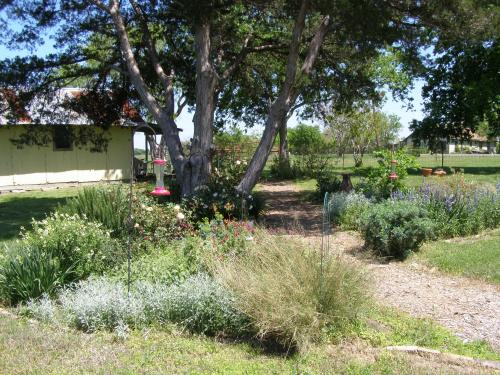
From our back door ( photo / image / picture from marlingardener's Garden ) and I walk through a butterfly gauntlet. The Queens and Hackberrys like the Gregg's Blue Mist and the Wafer Ash Tree, and don't get out of the way for anyone! 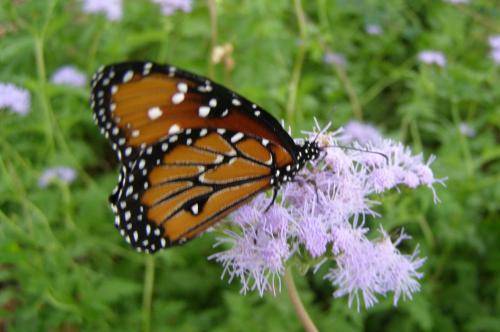
Queen butterfly on Greig's Blue Mist ( photo / image / picture from marlingardener's Garden ) Occasionally I get buzzed by a hummingbird that is at the feeder, or sipping nectar from the Salvia Greggii. After ducking and dodging the wildlife, I get to the workshop, and usually see the first bunny of the day. They like to hang out in the cool grass next to the workshop porch (it's a handy place to hide under if needed). Generally we are just part of the rabbits' landscape. They look at us, but figure we aren't important enough to merit running away! By the time I get past the workshop I can usually see two bunnies "binking" in the pasture. One chases the other, both stop, and then they do a synchronized reverse jump and the chaser becomes the chased. I take a look down the pasture to the pond to see if there are any water fowl up yet. We have great blue herons and white egrets almost year 'round, and in spring and fall, ducks. 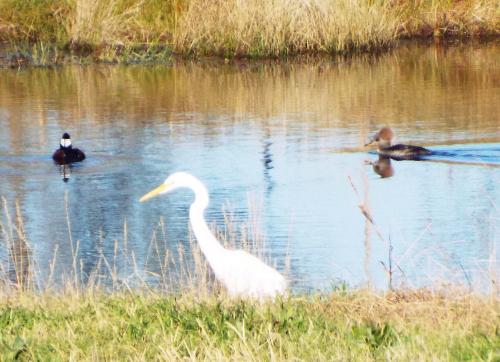
Two shovelers and an egret ( photo / image / picture from marlingardener's Garden ) Even if there isn't any activity at the pond, we still have collared doves and meadowlarks skimming the field, and our neighbor's Black Angus herd is slowly making its way from the night shed out to graze in the next field. When I get to the barn I can hear my girls cluckingâthey want their breakfast treat and to be let outside! 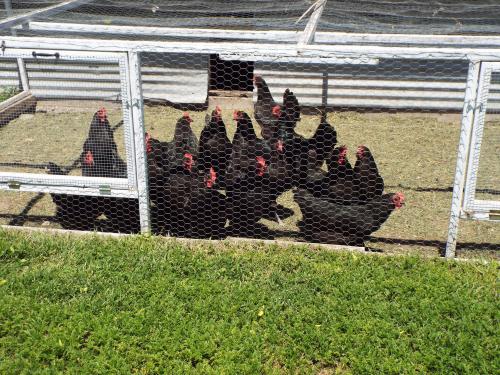
Photogenic hens ( photo / image / picture from marlingardener's Garden ) To get into the coop I have to toss treats away from the door, or they all crowd up against the door and I'm in danger of stepping on a hen. I scurry to the outside door and get it open before they gobble down their treats and start mobbing me for more. After checking the water and filling the feeder, I clean the coop and then visit the compost pile with the ladies' contribution to the richness of the soil. Heading back to the barn with the manure bucket, I usually take a long look at the sky. Texas has some of the most dramatic skies you could imagine, and it would be a shame to neglect taking a good look at the day's offering. 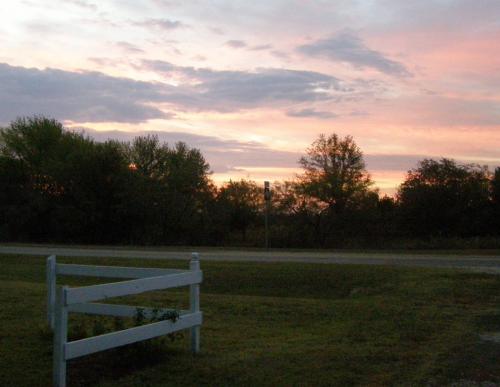
October Dawn ( photo / image / picture from marlingardener's Garden ) From the barn to the house is the same trip, reversed, but I pick up the pace a bit. By this time I want a cup of coffee and to find out what my husband has planned for the day. We might be clearing part of the vegetable garden for tilling, or picking almonds (we are all the way up to 60 almonds!), or mowing, or any of the many interesting ways a person can spend the day on a farm. The walk to the barn just gets the day started well. This blog entry has been viewed 303 times
You're reading one of many blogs on GardenStew.com.
Register for free and start your own blog today. |
|
